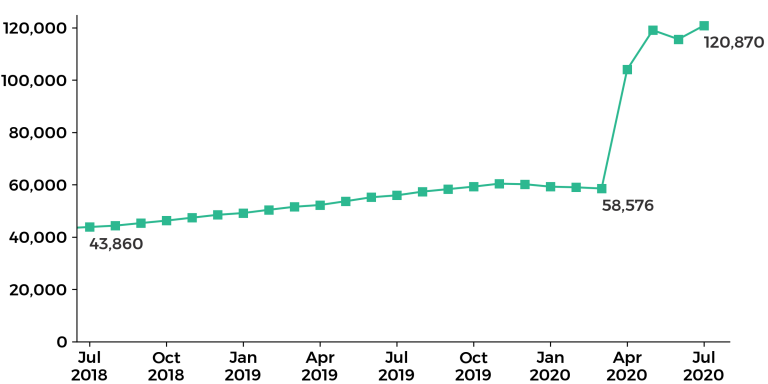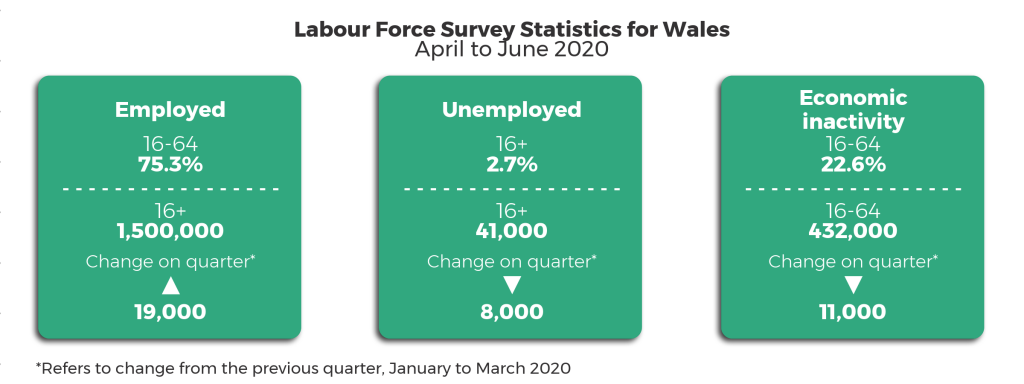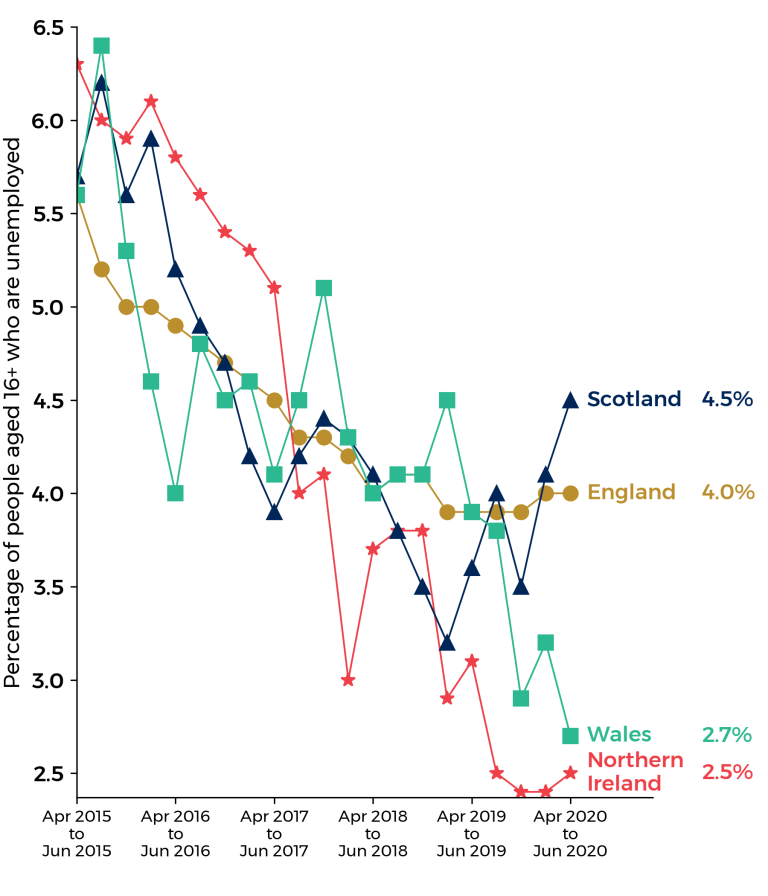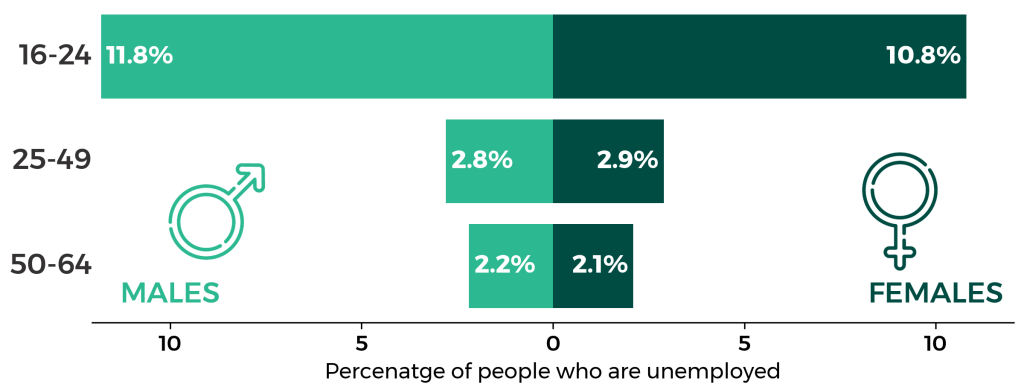11 August 2020
Have official statistics started to reflect the impact of coronavirus on the labour market?
Each month the Office for National Statistics (ONS) publishes estimates of employment and unemployment rates. These estimates are based on information collected by the Labour Force Survey (LFS) for the preceding three-month period. The time lag to these figures means that the latest labour market release published on 11 August 2020 provides information from April 2020 to June 2020, the period after the implementation of coronavirus social distancing measures. The August LFS figures do not reflect the number of people who have been placed on furlough due to coronavirus.
The latest HMRC statistics on the Coronavirus Job Retention Scheme show 378,400 employments in Wales have been furloughed up to 30 June 2020. This represents a take up rate of 29%, the lowest along with East and South East England when compared to all the UK countries and English regions. In terms of constituencies, Cardiff North (23%) has the lowest take up rate and Dwyfor Meirionnydd (40%) the highest take up rate in Wales.
Are there other data we can use to see the impact of coronavirus on the labour market in Wales?
Claimant count figures are published monthly and are more timely. However, people in work can also be eligible for Universal Credit and included in the claimant count. ONS states;
As part of the response to the pandemic, the rules about who can claim Universal Credit have changed, meaning an increased proportion of those claiming may actually still be in some kind of work. Because of these reasons, the change in the claimant count almost certainly ends up overstating any underlying change in unemployment.
ONS has also been working with HMRC to produce estimates of employees being paid through the PAYE system. The PAYE data from March to July showed a reduction of 730,000 people in the UK being paid through this system. These data are not yet available at a Wales level.
Claimant count – seasonally adjusted
ONS publishes an experimental series counting the number of people claiming Jobseeker's Allowance plus those who claim Universal Credit and are required to seek work and be available for work. This replaces the number of people claiming Jobseeker's Allowance as the headline indicator of the number of people claiming benefits principally for the reason of being unemployed. The latest data for July 2020 show that the Wales claimant count went up from 58,576 in March 2020 to 120,870 in July 2020, an increase from 115,623 in June 2020.
Claimant count for Wales; July 2018 to July 2020

Notes: From May 2013 onwards these figures are considered Experimental Statistics. Under Universal Credit a broader span of claimants are required to look for work than under Jobseeker's Allowance. As Universal Credit Full Service is rolled out in particular areas, the number of people recorded as being on the Claimant Count is likely to rise. Rates for regions and countries from 2018 onwards are calculated using the mid-2018 resident population aged 16-64.
What do the latest Labour Force Survey figures show?
The Labour Force Survey (LFS) is a quarterly household survey of around 80,000 adults. The survey asks a range of questions on employment and the labour market. As people are still furloughed this doesn’t reflect the full impact of coronavirus on the labour market in Wales.
For April 2020 to June 2020 the unemployment rate for people aged 16+ in Wales was 2.7%, compared to 3.2% in the previous quarter (January 2020 to March 2020). This is a decrease of 8,000 people from the previous quarter down to 41,000.

Source: ONS, Regional labour market: Headline indicators for Wales
The unemployment rate in Wales (2.7%) is lower than England (4.0%) and Scotland (4.5%), and higher than Northern Ireland (2.5%).
Percentage of people aged 16+ who are unemployed, UK nations; April 2015 - June 2015 to April 2020 - June 2020

Data from the LFS are available showing the unemployment rate by sex and age for 12 months to March 2020. The latest data show unemployment rates decrease with age for both males and females. In the 16-24 and 50-64 age groups males have higher unemployment rates than females.
Unemployment rate by age and sex in Wales; 12 months to March 2020

Unemployment data are also available by parliamentary constituency. The interactive map below shows for the 12 months to March 2020 Neath had the highest rate (7.0%) and Montgomeryshire the lowest rate (2.0%).

Definitions
The number of unemployed people in the UK includes people who meet the definition of unemployment specified by the International Labour Organisation (ILO). The ILO defines unemployed people as being:
- without a job, have been actively seeking work in the past four weeks and are available to start work in the next two weeks
- out of work, have found a job and are waiting to start it in the next two weeks
Employment measures the number of people aged 16 years and over in paid work. The headline measure of employment for the UK is the employment rate for those aged from 16 to 64 years.
The headline measure of inactivity for the UK is the rate of those aged from 16 to 64 without a job who have not sought work in the last four weeks and/or are not available to start work in the next two weeks.
Article by Joe Wilkes and Helen Jones, Senedd Research, Welsh Parliament
We’ve published a range of material on the coronavirus pandemic, including a post setting out the help and guidance available for people in Wales and a timeline of Welsh and UK governments’ response.
You can see all our coronavirus-related publications by clicking here. All are updated regularly.






